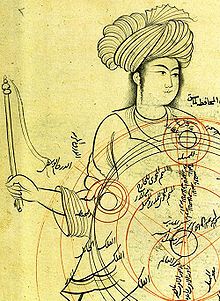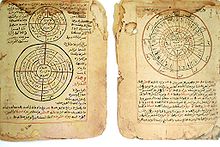- Astronomy in medieval Islam
-
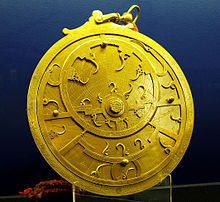 An 18th century Persian Astrolabe, kept at The Whipple Museum of the History of Science in Cambridge, England.
An 18th century Persian Astrolabe, kept at The Whipple Museum of the History of Science in Cambridge, England.
Islamic astronomy or Arabic astronomy comprises the astronomical developments made in the Islamic world, particularly during the Islamic Golden Age (8th–15th centuries),[1] and mostly written in the Arabic language. These developments mostly took place in the Middle East, Central Asia, Al-Andalus, and North Africa, and later in the Far East and India. It closely parallels the genesis of other Islamic sciences in its assimilation of foreign material and the amalgamation of the disparate elements of that material to create a science with Islamic characteristics. These included Greek, Sassanid, and Indian works in particular, which were translated and built upon.[2] In turn, Islamic astronomy later had a significant influence on Indian,[3] Byzantine[4] and European[5] astronomy (see Latin translations of the 12th century) as well as Chinese astronomy[6] and Malian astronomy.[7][8]
A significant number of stars in the sky, such as Aldebaran and Altair, and astronomical terms such as alhidade, azimuth, and almucantar, are still referred to by their Arabic names.[9] A large corpus of literature from Islamic astronomy remains today, numbering approximately 10,000 manuscripts scattered throughout the world, many of which have not been read or catalogued. Even so, a reasonably accurate picture of Islamic activity in the field of astronomy can be reconstructed.[10]
Contents
History
 Muhammad Salih Tahtawi of Sindh headed the task of creating a massive, seamless celestial globe using a secret wax casting method in the Mughal Empire, the famous celestial globe of Muhammad Salih Tahtawi is inscribed with Arabic and Persian inscriptions and was completed in the year 1631.[11]
Muhammad Salih Tahtawi of Sindh headed the task of creating a massive, seamless celestial globe using a secret wax casting method in the Mughal Empire, the famous celestial globe of Muhammad Salih Tahtawi is inscribed with Arabic and Persian inscriptions and was completed in the year 1631.[11]
Ahmad Dallal notes that, unlike the Babylonians, Greeks, and Indians, who had developed elaborate systems of mathematical astronomical study, the pre-Islamic Arabs relied entirely on empirical observations. These observations were based on the rising and setting of particular stars, and this area of astronomical study was known as anwa. Anwa continued to be developed after Islamization by the Arabs, where Islamic astronomers added mathematical methods to their empirical observations.[12] According to David King, after the rise of Islam, the religious obligation to determine the qibla and prayer times inspired more progress in astronomy for centuries.[13]
Hill (1993) divided Islamic Astronomy into the four following distinct time periods in its history:
700-825
The period of assimilation and syncretisation of earlier Hellenistic, Indian, and Sassanid astronomy.
During this period many Indian and Persian texts were translated into Arabic. The most notable of the texts was Zij al-Sindhind,[n 1] translated by Muhammad ibn Ibrahim al-Fazari and Yaqub ibn Tariq in 777. The text was translated after an Indian astronomer visited the court of caliph Al-Mansur in 770. Another text translated was the Zij al-Shah, a collection of astronomical tables compiled in Persia over two centuries. Fragments of text during this period indicate that Arabs adopted the sine function (inherited from India) in place of the chords of arc used in Greek trignometry.[12]
825-1025
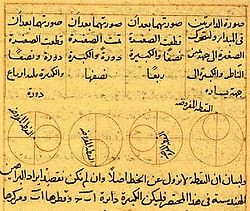 The Tusi-couple is a mathematical device invented by Nasir al-Din al-Tusi in which a small circle rotates inside a larger circle twice the diameter of the smaller circle. Rotations of the circles cause a point on the circumference of the smaller circle to oscillate back and forth in linear motion along a diameter of the larger circle.
The Tusi-couple is a mathematical device invented by Nasir al-Din al-Tusi in which a small circle rotates inside a larger circle twice the diameter of the smaller circle. Rotations of the circles cause a point on the circumference of the smaller circle to oscillate back and forth in linear motion along a diameter of the larger circle.
This period of vigorous investigation, in which the superiority of the Ptolemaic system of astronomy was accepted and significant contributions made to it. Astronomical research was greatly supported by the Abbasid caliph al-Mamun. Baghdad and Damascus became the centers of such activity. The caliphs not only supported this work financially, but endowed the work with formal prestige.
The first major Muslim work of astronomy was Zij al-Sindh by al-Khwarizimi in 830. The work contains tables for the movements of the sun, the moon and the five planets known at the time. The work is significant as it introduced Ptolemaic concepts into Islamic sciences. This work also marks the turning point in Islamic astronomy. Hitherto, Muslim astronomers had adopted a primarily research approach to the field, translating works of others and learning already discovered knowledge. Al-Khwarizmi's work marked the beginning of nontraditional methods of study and calculations.[14]
In 850, al-Farghani wrote Kitab fi Jawani (meaning "A compendium of the science of stars"). The book primarily gave a summary of Ptolemic cosmography. However, it also corrected Ptolemy based on findings of earlier Arab astronomers. Al-Farghani gave revised values for the obliquity of the ecliptic, the precessional movement of the apogees of the sun and the moon, and the circumference of the earth. The book was widely circulated through the Muslim world, and even translated into Latin.[15]
1025-1450
The period when a distinctive Islamic system of astronomy flourished. The period began as the Muslim astronomers began questioning the framework of the Ptolemaic system of astronomy. These criticisms, however, remained within the geocentric framework and followed Ptolemy's astronomical paradigm; one historian described their work as "a reformist project intended to consolidate Ptolemaic astronomy by bringing it into line with its own principles."[16]
In 1070, Abu Ubayd al-Juzjani published the Tarik al-Aflak. In his work, he indicated the so-called "equant" problem of the Ptolemic model. Al-Juzjani even proposed a solution for the problem. In al-Andalus, the anonymous work al-Istidrak ala Batlamyus (meaning "Recapitulation regarding Ptolemy"), included a list of objections to the Ptolemic astronomy.
The most important work, however, was Al-Shuku ala Batlamyus (meaning "Doubts on Ptolemy"). In this, the author summed up the inconsistencies of the Ptolemic models. Many astronomers took up the challenge posed in this work, namely to develop alternate models that evaded such errors. The most important of these astronomers include: Mu'ayyad al-Din al-'Urdi (c. 1266), Nasir al-Din al-Tusi (1201–74), Qutb al-Din al Shirazi (c. 1311), Sadr al-Sharia al-Bukhari (c. 1347), Ibn al-Shatir (c. 1375), and Ali al-Qushji (c. 1474).[17]
1450-1900
The period of stagnation, when the traditional system of astronomy continued to be practised with enthusiasm, but with rapidly decreasing innovation of any major significance.
A large corpus of literature from Islamic astronomy remains today, numbering around some 10,000 manuscript volumes scattered throughout the world. Much of this has not even been catalogued. Even so, a reasonably accurate picture of Islamic activity in the field of astronomy can be reconstructed.
Observatories
The first systematic observations in Islam are reported to have taken place under the patronage of al-Mamun. Here, and in many other private observatories from Damascus to Baghdad, meridian degrees were measured, solar parameters were established, and detailed observations of the Sun, Moon, and planets were undertaken.
In the 10th century, the Buwayhid dynasty encouraged the undertaking of extensive works in Astronomy, such as the construction of a large scale instrument with which observations were made in the year 950. We know of this by recordings made in the zij of astronomers such as Ibn al-Alam. The great astronomer Abd Al-Rahman Al Sufi was patronised by prince Adud o-dowleh, who systematically revised Ptolemy's catalogue of stars. Sharaf al-Daula also established a similar observatory in Baghdad. And reports by Ibn Yunus and al-Zarqall in Toledo and Cordoba indicate the use of sophisticated instruments for their time.
It was Malik Shah I who established the first large observatory, probably in Isfahan. It was here where Omar Khayyám with many other collaborators constructed a zij and formulated the Persian Solar Calendar a.k.a. the jalali calendar. A modern version of this calendar is still in official use in Iran today.
The most influential observatory was however founded by Hulegu Khan during the 13th century. Here, Nasir al-Din al-Tusi supervised its technical construction at Maragha. The facility contained resting quarters for Hulagu Khan, as well as a library and mosque. Some of the top astronomers of the day gathered there, and from their collaboration resulted important modifications to the Ptolemaic system over a period of 50 years.
The Ulugh Beg Observatory in Samarqand.
In 1420, prince Ulugh Beg, himself an astronomer and mathematician, founded another large observatory in Samarkand, the remains of which were excavated in 1908 by Russian teams.
And finally, Taqi al-Din Muhammad ibn Ma'ruf founded a large observatory in Istanbul in 1577, which was on the same scale as those in Maragha and Samarkand. The observatory was short-lived however, as opponents of the observatory and prognostication from the heavens prevailed and the observatory was destroyed in 1580.[18] Other sources give the "rise of a clerical faction," which opposed or at least was indifferent to science,[19] and specifically to "the recommendation of the Chief Mufti" of the Ottomans, as the explanation for the destruction of the observatory.[20]
Instruments
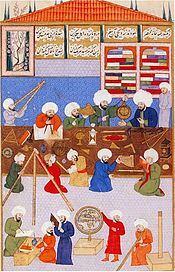 Work in the observatorium of Taqi al-Din.
Work in the observatorium of Taqi al-Din.
Our knowledge of the instruments used by Muslim astronomers primarily comes from two sources. First the remaining instruments in private and museum collections today, and second the treatises and manuscripts preserved from the Middle Ages.
Muslims made many improvements to instruments already in use before their time, such as adding new scales or details. Their contributions to astronomical instrumentation are abundant.
Celestial globes and armillary spheres
Celestial globes were used primarily for solving problems in celestial astronomy. Today, 126 such instruments remain worldwide, the oldest from the 11th century. The altitude of the sun, or the Right Ascension and Declination of stars could be calculated with these by inputting the location of the observer on the meridian ring of the globe.
An armillary sphere had similar applications. No early Islamic armillary spheres survive, but several treatises on “the instrument with the rings” were written. In this context there is also an Islamic development, the spherical astrolabe, of which only one complete instrument, from the 14th century, has survived.
Astrolabes
Brass astrolabes were developed in much of the Islamic world, chiefly as an aid to finding the qibla. The earliest known example is dated 315 (in the Islamic calendar, corresponding to 927-8). The first person credited for building the Astrolabe in the Islamic world is reportedly Fazari (Richard Nelson Frye: Golden Age of Persia. p163). He only improved it though, the Greeks had already invented astrolabes to chart the stars. The Arabs then took it during the Abbasid Dynasty and perfected it to be used to find the beginning of Ramadan, the hours of prayer, and the direction of Mecca.
The instruments were used to read the rise of the time of rise of the Sun and fixed stars. al-Zarqall of Andalusia constructed one such instrument in which, unlike its predecessors, did not depend on the latitude of the observer, and could be used anywhere. This instrument became known in Europe as the Saphea.
Sundials
Muslims made several important improvements to the theory and construction of sundials, which they inherited from their Indian and Greek predecessors. Khwarizmi made tables for these instruments which considerably shortened the time needed to make specific calculations.
Sundials were frequently placed on mosques to determine the time of prayer. One of the most striking examples was built in the 14th century by the muwaqqit (timekeeper) of the Umayyid Mosque in Damascus, ibn al-Shatir.[22]
Quadrants
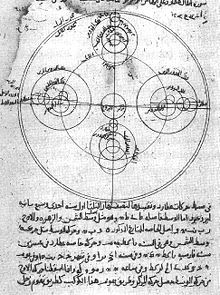 Ibn al-Shatir's model for the appearances of Mercury, showing the multiplication of epicycles using the Tusi-couple, thus eliminating the Ptolemaic eccentrics and equant.
Ibn al-Shatir's model for the appearances of Mercury, showing the multiplication of epicycles using the Tusi-couple, thus eliminating the Ptolemaic eccentrics and equant.
Several forms of quadrants were invented by Muslims. Among them was the sine quadrant used for astronomical calculations and various forms of the horary quadrant, used to determine time (especially the times of prayer) by observations of the Sun or stars. A center of the development of quadrants was ninth-century Baghdad.[23]
Equatorium
The Equatorium is an Islamic invention from Al-Andalus. The earliest known was probably made around 1015. It is a mechanical device for finding the positions of the Moon, Sun, and planets, without calculation using a geometrical model to represent the celestial body's mean and anomalistic position.
See also
- History of astronomy
- Hebrew astronomy
- Qibla
- Astrology in medieval Islam
- List of Muslim astronomers
- List of Iranian scientists
- House of Wisdom
- Islamic Golden Age
Notes and references
- Notes
- ^ This book is not related to al-Khwarizmi's Zij al-Sindh. On zijes see E. S. Kennedy, "A Survey of Islamic Astronomical Tables".
- Citations
- ^ (Saliba 1994b, pp. 245, 250, 256–257)
- ^ (Gingerich 1986)
- ^ Sharma, Virendra Nath (1995), Sawai Jai Singh and His Astronomy, Motilal Banarsidass Publ., pp. 8–10, ISBN 8120812565
- ^ Joseph Leichter (June 27, 2009). "The Zij as-Sanjari of Gregory Chioniades". Internet Archive. http://www.archive.org/details/TheZijAs-sanjariOfGregoryChioniades. Retrieved 2009-10-02.
- ^ Saliba (1999).
- ^ van Dalen, Benno (2002), "Islamic Astronomical Tables in China: The Sources for Huihui li", in Ansari, S. M. Razaullah, History of Oriental Astronomy, Springer Science+Business Media, pp. 19–32, ISBN 1402006578
- ^ African Cultural Astronomy By Jarita C. Holbrook, R. Thebe Medupe, Johnson O. Urama
- ^ Medupe, Rodney Thebe; Warner, Brian; Jeppie, Shamil; Sanogo, Salikou; Maiga, Mohammed; Maiga, Ahmed; Dembele, Mamadou; Diakite, Drissa et al. (2008), "The Timbuktu Astronomy Project", African Cultural Astronomy, Astrophysics and Space Science Proceedings, pp. 179, doi:10.1007/978-1-4020-6639-9_13, ISBN 978-1-4020-6638-2.
- ^ "Arabic Star Names". Islamic Crescents' Observation Project. 2007-05-01. http://www.icoproject.org/star.html. Retrieved 2008-01-24.
- ^ (Ilyas 1997)
- ^ Savage-Smith, Emilie (1985), Islamicate Celestial Globes: Their History, Construction, and Use, Smithsonian Institution Press, Washington, D.C.
- ^ a b Dallal (1999), pg. 162
- ^ King, David A. (2005-06-30). In Synchrony with the Heavens, Studies in Astronomical Timekeeping and Instrumentation in Medieval Islamic Civilization: The Call of the Muezzin. 1. Brill Academic Pub. p. xvii. ISBN 900414188X. "And it so happens that the particular intellectual activity that inspired these materials is related to the religious obligation to pray at specific times. The material presented here makes nonsense of the popular modern notion that religion inevitably impedes scientific progress, for in this case, the requirements of the former actually inspired the progress of the latter for centuries."
- ^ Dallal (1999), pg. 163
- ^ Dallal (1999), pg. 164
- ^ Sabra, "Configuring the Universe," p. 322.
- ^ Dallal (1999), pg. 171
- ^ John Morris Roberts, The History of the World, pp. 264-74, Oxford University Press, ISBN 978-0195210439
- ^ Islamic Technology: An Illustrated History by Ahmad Y. al-Hassan and Donald Hill, Cambridge University Press, 1986, p.282
- ^ Aydin Sayili, The Observatory in Islam and its place in the General History of the Observatory (Ankara: 1960), pp. 289 ff
- ^ http://www.saudiaramcoworld.com/issue/201105/from.africa.in.ajami.htm
- ^ David A. King, "Islamic Astronomy," pp. 168-9.
- ^ David A. King, "Islamic Astronomy," pp. 167-8.
- Bibliography
- Adnan, Abdulhak (1939), La science chez les Turcs ottomans, Paris
- Ajram, K. (1992), "Appendix B", Miracle of Islamic Science, Knowledge House Publishers, ISBN 0911119434
- Baker, A.; Chapter, L. (2002), "Part 4: The Sciences", in Sharif, M. M., "A History of Muslim Philosophy", Philosophia Islamica
- Covington, Richard, "Rediscovering Arabic science", Saudi Aramco World (May–June 2007 ed.), pp. 2–16[unreliable source?]
- Dallal, Ahmad (1999), "Science, Medicine and Technology", in Esposito, John, The Oxford History of Islam, Oxford University Press, New York
- Duhem, Pierre (1908, 1969), To Save the Phenomena: An Essay on the Idea of Physical theory from Plato to Galileo, University of Chicago Press, Chicago, ISBN 0226169219
- Gautier, Antoine (December 2005), "L'âge d'or de l'astronomie ottomane", L'Astronomie (monthly magazine created by Camille Flammarion in 1882), 119
- Gill, M. (2005), Was Muslim Astronomy the Harbinger of Copernicanism?, http://www.chowk.com/articles/9489, retrieved 2008-01-22
- Gingerich, Owen (April 1986), "Islamic astronomy", Scientific American 254 (10): 74, Bibcode 1986SciAm.254...74G, http://faculty.kfupm.edu.sa/PHYS/alshukri/PHYS215/Islamic_astronomy.htm, retrieved 2008-05-18
- Glick, Thomas F.; Livesey, Steven John; Wallis, Faith (2005), Medieval Science, Technology, and Medicine: An Encyclopedia, Routledge, ISBN 0415969301
- Hassan, Ahmad Y., Transfer Of Islamic Technology To The West, Part II: Transmission Of Islamic Engineering, http://www.history-science-technology.com/Articles/articles%2071.htm, retrieved 2008-01-22
- Hill, Donald R. (1985), "Al-Biruni's mechanical calendar", Annals of Science 42 (2): 139–163, doi:10.1080/00033798500200141
- Hill, Donald R. (May 1991), "Mechanical Engineering in the Medieval Near East", Scientific American: 64–69 (cf. Hill, Donald R., Mechanical Engineering, ISBN 0070378630, http://home.swipnet.se/islam/articles/HistoryofSciences.htm, retrieved 2008-01-22)
- Hill, Donald R. (1993), Islamic Science And Engineering, Edinburgh University Press, ISBN 0-7486-0455-3
- Huff, Toby (2003), The Rise of Early Modern Science: Islam, China, and the West, Cambridge University Press, ISBN 0521529948
- Ilyas, Mohammad (1997), Islamic Astronomy, Pelanduk Publications, ISBN 9679785491
- Iqbal, Muzaffar (2003), "Review: World-Maps for Finding the Direction and Distance to Mecca: Innovation and Tradition in Islamic Science by David A. King", Islam & Science, June 2003
- Iqbal, Muzaffar; Berjak, Rafik (2003), "Ibn Sina–Al-Biruni correspondence", Islam & Science, June 2003
- Kennedy, Edward S. (1947), "Al-Kashi's Plate of Conjunctions", Isis 38 (1–2): 56–59, doi:10.1086/348036
- Kennedy, Edward S. (1950), "A Fifteenth-Century Planetary Computer: al-Kashi's "Tabaq al-Manateq" I. Motion of the Sun and Moon in Longitude", Isis 41 (2): 180–183, doi:10.1086/349146
- Kennedy, Edward S. (1951), "An Islamic Computer for Planetary Latitudes", Journal of the American Oriental Society (Journal of the American Oriental Society, Vol. 71, No. 1) 71 (1): 13–21, doi:10.2307/595221, JSTOR 595221
- Kennedy, Edward S. (1952), "A Fifteenth-Century Planetary Computer: al-Kashi's "Tabaq al-Maneteq" II: Longitudes, Distances, and Equations of the Planets", Isis 43 (1): 42–50, doi:10.1086/349363
- Kennedy, Edward S. (1956), "A Survey of Islamic Astronomical Tables", Transactions of the American Philosophical Society (Transactions of the American Philosophical Society, Vol. 46, No. 2) 46 (2): 123, doi:10.2307/1005726, JSTOR 1005726
- Kennedy, Edward S. (1961), "Al-Kashi's Treatise on Astronomical Observational Instruments", Journal of Near Eastern Studies 20 (2): 98–108, doi:10.1086/371617
- Kennedy, Edward S. (1962), "Review: The Observatory in Islam and Its Place in the General History of the Observatory by Aydin Sayili", Isis 53 (2): 237–239, doi:10.1086/349558
- Kennedy, Edward S. (1998), Astronomy and Astrology in the Medieval Islamic World, Brookfield, VT: Ashgate, ISBN 086078682X
- King, David A. (1983), "The Astronomy of the Mamluks", Isis 74 (4): 531–555, doi:10.1086/353360
- King, David A. (1986), Islamic mathematical astronomy, London, ISBN 086078407X
- King, David A. (1997), "Two Iranian World Maps for Finding the Direction and Distance to Mecca", Imago Mundi 49 (1): 62–82, doi:10.1080/03085699708592859
- King, David A. (1999a), "Islamic Astronomy", in Walker, Christopher, Astronomy before the telescope, British Museum Press, pp. 143–174, ISBN 0-7141-2733-7
- King, David A. (1999b), World-maps for Finding the Direction and Distance to Mecca: Innovation and Tradition in Islamic Science, Brill Publishers, ISBN 9004113673
- King, David A. (2002), "A Vetustissimus Arabic Text on the Quadrans Vetus", Journal for the History of Astronomy 33: 237–255, Bibcode 2002JHA....33..237K
- King, David A. (December 2003), "14th-Century England or 9th-Century Baghdad? New Insights on the Elusive Astronomical Instrument Called Navicula de Venetiis", Centaurus 45 (1–4): 204–226, doi:10.1111/j.1600-0498.2003.450117.x
- King, David A. (2004), "Reflections on some new studies on applied science in Islamic societies (8th–19th centuries)", Islam & Science, June 2004
- King, David A. (2005), In Synchrony with the Heavens, Studies in Astronomical Timekeeping and Instrumentation in Medieval Islamic Civilization: Instruments of Mass Calculation, Brill Publishers, ISBN 900414188X
- King, David A.; Cleempoel, Koenraad Van; Moreno, Roberto (2002), "A Recently Discovered Sixteenth-Century Spanish Astrolabe", Annals of Science 59 (4): 331–362, doi:10.1080/00033790110095813
- Langermann, Y. Tzvi, ed. and trans. (1990), Ibn al-Haytham's On the Configuration of the World, Harvard Dissertations in the History of Science, New York: Garland, ISBN 0824000412
- Marmura, Michael E.; Nasr, Seyyed Hossein (1965), "Review: An Introduction to Islamic Cosmological Doctrines. Conceptions of Nature and Methods Used for Its Study by the Ikhwan Al-Safa'an, Al-Biruni, and Ibn Sina by Seyyed Hossein Nasr", Speculum (Speculum, Vol. 40, No. 4) 40 (4): 744–746, doi:10.2307/2851429, JSTOR 2851429
- Marshall, O. S. (1950), "Alhazen and the Telescope", Astronomical Society of the Pacific Leaflets 6: 4
- Nasr, Seyyed H. (1st edition in 1964, 2nd edition in 1993), An Introduction to Islamic Cosmological Doctrines (2nd ed.), 1st edition by Harvard University Press, 2nd edition by State University of New York Press, ISBN 0791415155
- Ragep, F. Jamil (2001a), "Tusi and Copernicus: The Earth's Motion in Context", Science in Context (Cambridge University Press) 14 (1–2): 145–163
- Ragep, F. Jamil (2001b), "Freeing Astronomy from Philosophy: An Aspect of Islamic Influence on Science", Osiris, 2nd Series 16 (Science in Theistic Contexts: Cognitive Dimensions): 49–64 & 66–71, Bibcode 2001Osir...16...49R
- Ragep, F. Jamil; Teresi, Dick; Hart, Roger (2002), Ancient Roots of Modern Science, Talk of the Nation (National Public Radio discussion; astronomy is discussed in the first fifteen-minute segment), http://www.npr.org/templates/story/story.php?storyId=885213, retrieved 2008-01-22
- Rashed, Roshdi; Morelon, Régis (1996), Encyclopedia of the History of Arabic Science, 1, & 3, Routledge, ISBN 0415124107
- Rashed, Roshdi (2007), "The Celestial Kinematics of Ibn al-Haytham", Arabic Sciences and Philosophy (Cambridge University Press) 17 (01): 7–55, doi:10.1017/S0957423907000355
- Rosen, Edward (1985), "The Dissolution of the Solid Celestial Spheres", Journal of the History of Ideas (Journal of the History of Ideas, Vol. 46, No. 1) 46 (1): 13–31, doi:10.2307/2709773, JSTOR 2709773
- Sabra, A. I. (1998), "Configuring the Universe: Aporetic, Problem Solving, and Kinematic Modeling as Themes of Arabic Astronomy", Perspectives on Science 6: 288–330
- Saliba, George (1979), "The First Non-Ptolemaic Astronomy at the Maraghah School", Isis 70 (4): 571–576, doi:10.1086/352344
- Saliba, George (1980), "Al-Biruni", in Strayer, Joseph, Dictionary of the Middle Ages, 2, Charles Scribner's Sons, New York
- Saliba, George; Sezgin, F. (1981), "Review: Geschichte des arabischen Schriftiums. Band VI: Astronomie bis ca. 430 H by F. Sezgin", Journal of the American Oriental Society (Journal of the American Oriental Society, Vol. 101, No. 2) 101 (2): 219–221, doi:10.2307/601763, JSTOR 601763
- Saliba, George (1994a), "Early Arabic Critique of Ptolemaic Cosmology: A Ninth-Century Text on the Motion of the Celestial Spheres", Journal for the History of Astronomy 25: 115–141, Bibcode 1994JHA....25..115S
- Saliba, George (1994b), A History of Arabic Astronomy: Planetary Theories During the Golden Age of Islam, New York University Press, ISBN 0814780237
- Saliba, George (1999), Whose Science is Arabic Science in Renaissance Europe?, Columbia University, http://www.columbia.edu/~gas1/project/visions/case1/sci.1.html, retrieved 2008-01-22
- Saliba, George (2000), "Arabic versus Greek Astronomy: A Debate over the Foundations of Science", Perspectives on Science 8 (4): 328–341, doi:10.1162/106361400753373713
- Saliba, George (2007), Lecture at SOAS, London – Part 3/7, Muslim Heritage & YouTube, http://www.youtube.com/watch?v=IkL5Klh9WlY, retrieved 2008-01-22
- Singer, C. (1959), A Short History of Scientific Ideas, Oxford University Press, ISBN 0198810490
- Suter, H. (1902), Mathematiker und Astronomen der Araber
- Tabatabaei, Seyyed Muhammad Husayn, Tafsir al-Mizan
- Wickens, G. M. (1976), "The Middle East as a world Centre of science and medicine", in Savory, Roger M., Introduction to Islamic Civilization, Cambridge University Press, pp. 111–118, ISBN 052109948X
External links
- "Tubitak Turkish National Observatory Antalya"
- "Scientific American" article on Islamic Astronomy
- The Arab Union for Astronomy and Space Sciences (AUASS)
- King Abdul Aziz Observatory
- History of Islamic Astrolabes
- Al-Sufi's constellations
Astronomy Main articles Methods Cultural astronomy Selected notable optical telescopes Islamic studies Arts 
Economics History Law & Politics Anarchism • Democracy (Consensus • Consultation) • Feminism • Jurisprudence (Analogy • Ijtihad • Madh'hab) • Peace • Quietism • Secularism • Social Changes • StatePhilosophy Early Philosophy • Contemporary Philosophy • Theology (Kalam) • Ethics • Logic • Metaphysics • Astrology • Sociology (Medieval Sociology • Asabiyyah)Science & Technology Timeline • Agriculture • Alchemy & Chemistry • Astronomy (Cosmology) • Geography & Cartography • Inventions • Mathematics • Medicine (Ophthalmology) • Physics • PsychologyOther fields Categories:- History of astronomy
- Islamic Golden Age
- Islamic astronomy
Wikimedia Foundation. 2010.


